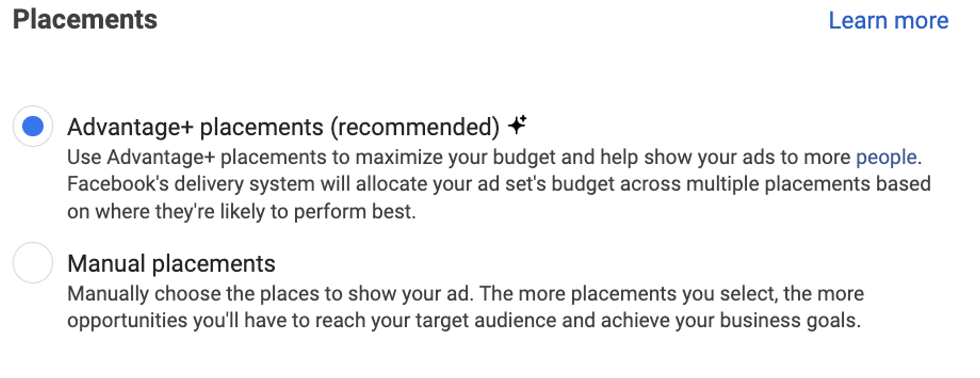Meta Advantage Ad Suite

As a result of the changing data privacy landscape, Meta has begun to push advertisers toward using machine learning features in their ad platforms. By leveraging Meta’s machine learning features, advertisers grant more optimization control to Meta to counteract the loss of signals from intelligent tracking prevention.
Following an announcement Meta shared in March 2022, five of its existing ad products will roll into two newly branded “Meta Advantage” products, which coincides with the overall company rebrand to reposition Meta to advertisers as an entire network of ad inventory (Facebook, Instagram, WhatsApp, etc.) that can be leveraged through their automated ad products. These newly branded Meta Advantage products include:
- Advantage+ settings: automation of specific selections within campaign settings. Advertisers have started to see these options that encourage them to enhance aspects of their campaigns marked “Advantage+.” This automatic placement has always been recommended but has now been rebranded as an Advantage+ product. A screenshot of this new setting is below:

- Advantage+ campaigns: automate a campaign from beginning to end. When creating a new campaign in the platform, advertisers will be greeted with the Advantage+ option with a workflow that leverages the entire suite of Meta Advantage products as opposed to advertisers being able to pick and choose.
Features most advertisers leverage — like lookalike audiences, detailed targeting expansion, app campaigns, automatic placements, and dynamic experiences — will now be branded under Meta’s Advantage+ products. As stated in the March announcement, Meta hopes this rebranding will further encourage advertisers to adopt its best practices and improve ad performance.
Since the ad platform took a big hit with the rollout of app tracking transparency, Meta has been focused on improving measurement and performance — specifically within the two areas most greatly impacted: app install campaigns and ecommerce/shopping campaigns. This product release is likely influenced by this loss in platform signals and measurability many advertisers have seen in the wake of the app tracking transparency rollout.
While Advantage+ app campaigns are available for advertisers now, Advantage+ shopping campaigns will be available soon. These campaign types are fully automated with the goal of helping advertisers automate the optimization of creative, targeting, and placements for product promotion. This may sound familiar to many performance marketers as it’s similar to how Google has evolved its shopping campaign offering (Smart Shopping & Performance Max), moving toward more automation across all of its owned inventory.
Key takeaways for marketers
As many performance media marketers have already discovered with Google, the push for greater automation is largely centered around the reduction of audience signals. This has meant many marketers have had to launch campaigns with a “start wide” approach, and then utilize campaign signals to optimize delivery quickly. This is nearly impossible to effectively do manually as had been done historically across all performance channels. While this may seem like platforms pushing advertisers out of the picture, it’s actually the opposite. Collective Measures has found that when we lean into automation with diligent oversight, performance does improve, making automation a viable and necessary strategy for performance marketing.
Moving forward, it will be important for advertisers to lean into testing Advantage+ products and campaigns to uncover if these automated features move the needle on performance compared to manual campaigns, while also remaining diligent to ensure the correct inputs are given to the platform and optimizations are implemented when the data are significant.



